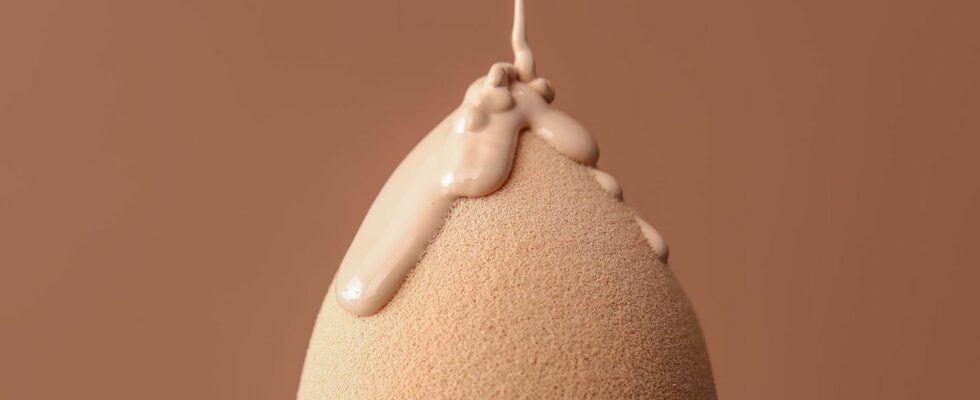Applying foundation isn’t always easy. We know this from our own experience. There are a few things that each of us has done wrong – and we’re learning from them now!
When we stand in front of the mirror in the morning and apply our make-up, we all probably think: That looks pretty good. As soon as we leave the house and look into the nearest window pane, we notice that it doesn’t do that. Damn! Why is that? Because we didn’t consider these eight things in the Foundation mission. And that will change from now on.
1. You don’t prepare the skin
Applying foundation to “bare” skin is not always a good idea. It is important that you ALWAYS use skin care underneath. No matter whether the make-up is moisturizing or minimally opaque – it doesn’t work without it. The result is often patchy and the product usually doesn’t lay well on the skin. However, the care should not be too rich, otherwise the foundation will slide back and forth. Many people use a primer after care. Can be done, does not have to be. However, if you want better hold, a luminous base or refined pores, you can definitely use a primer.
2. You are using the wrong tool
Do you always apply your foundation with your hands due to time constraints? In principle not bad at all. However, you should note that you should not apply every product with the same tool. Depending on whether you are working with a very light, liquid texture or with a highly opaque one, you should use different tools. To prevent the result from becoming patchy, you can always apply foundation with a brush first. If the result is too matt for you or the product sits too much on the skin, you can rework it with a beauty sponge.
3. You’re choosing the wrong undertone
After putting on makeup, have you ever wondered why you suddenly look like Miss Piggy or Bart Simpson himself? When it comes to foundation, it’s not just how light or dark it is that counts, but also the right undertone. Because it’s different for everyone. Generally there are yellow, pink, olive or neutral skin tones. If your makeup tone doesn’t match the color of your skin, the result can quickly look terrible. Especially in drugstores, it’s often difficult to find the right undertone because of the limited selection – but it’s definitely possible.
Before buying, test the foundation on your neck (and not your hands!) and wait a few minutes. Many products oxidize and darken. Be sure to look at the color in daylight – this way you can see the undertone much better.
4. You don’t know your skin type
If you have dry skin, you shouldn’t necessarily wear a mattifying foundation. Unless you want your skin to feel like the Sahara at the end of the day. For impure and oily skin, however, mattifying, highly covering products are perfect as they keep you matte for longer and also cover pimples and discoloration. Lighter formulations and foundations that promise glow are the better choice for dry skin. But as always: exceptions prove the rule. It doesn’t have to mean that those with dry skin can’t wear high-coverage products. You know, everyone’s skin is different. Sometimes it’s a great alternative to mix two foundations together to achieve the perfect result. Try it out!
5. You are taking too much product
A lot doesn’t always help a lot. When you put on make-up, it’s better to use less product than too much. We often misjudge the amount and the result just looks plastered over. Depending on what you use to apply the make-up, you should adjust the amount of product anyway. For example, a sponge absorbs more product than a brush. Only add more coverage to the areas where you need more coverage and do not apply several coats across the board. This not only saves you the hassle in the morning, but also saves you money because the foundation lasts longer.
6. You are following the wrong order
Cream products before powder products. If you’ve ever ignored this rule, then you know what happens. If you apply cream over powder, it often breaks down the powder textures and they are then removed from the skin. And you end up with a blotchy face and partially uncovered areas. That’s exactly what we don’t want. With a few exceptions – such as some cream highlighters – you should not use the powder products first. So first apply foundation, concealer etc. – and only then can you move on to powder, blush and bronzer.
7. You’re putting makeup on in the wrong light
Doing your makeup in front of the miniature bathroom mirror with no light on is not really a good idea. Because if you don’t have good light, you won’t be able to see colors or details properly. This usually ends with makeup edges or way too much color. If you don’t have the opportunity to do your make-up in daylight, just try out a daylight lamp. There are now even mirrors that have integrated lights or real beauty lights. This works wonders and takes your makeup game to a new level. No lie!
8. You don’t do your makeup
What you do with your face after applying foundation is just as important as what you do beforehand. Foundation and concealer in particular should be set with powder after application. This isn’t a must, but it ensures that your make-up lasts much longer and you don’t immediately wipe it off your face when you touch your face with your hands. If you don’t want to cover your entire face with powder, you should at least powder the T-zone. This is where we usually shine first. Our tip: Always have a transparent powder or blotting paper in your bag – then nothing can happen to your make-up when you’re on the go.
